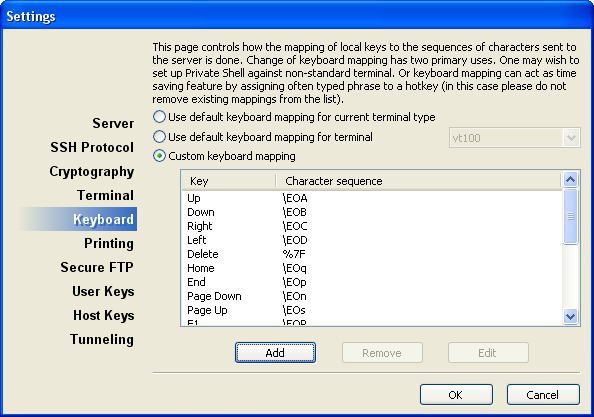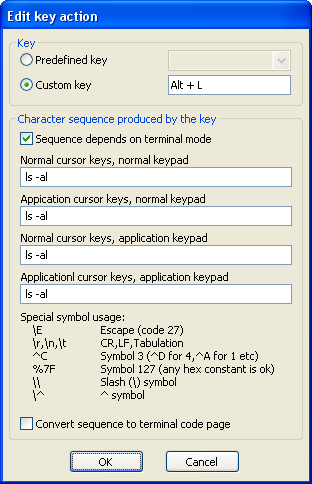3.5 Keyboard Mapping
Keyboard mapping is a new useful feature available in Private Shell
1.4. By using it you can define the character sequence that is sent to the
server when you press a specific key.
This has two primary uses - you can customize Private Shell to
work with non-standard terminal servers or use this feature as a
macro to save time by assigning often-typed phrases to hotkeys.
Use default keyboard mapping for current terminal type
Tells Private Shell to use default keyboard mapping for currently
selected terminal type. (Hint: the current terminal type is selected
in the Terminal page).
Use default keyboard mapping for terminal
Tells Private Shell to use standard keyboard mapping for a specific
terminal. In this case you can select a terminal type from the
list of available types located to the right of this option.
Custom keyboard mapping
This option lets you set up your own keyboard mapping. In most cases
it is enough only to edit existing items if you want to
customize Private Shell to work with a non-standard
terminal server. This is done by selecting an item in the list and
clicking the "Edit" button. You will see the "Edit Key Action"
dialog.
However, if you want to assign an often-typed phrase to a hot-key,
you should click the "Add" button. You shouldn't delete or edit
existing key mappings in such a case because it can lead to
partial or full Private Shell inoperability.
You can use the "Remove" button to delete selected
key mapping from the list.
Edit Key Action Dialog
Predefined key / Custom Key
Usually you check the "Custom key" option and
enter the desired hotkey in the corresponding field.
But you cannot enter keys like
"Enter", "Space", "Escape" etc. in this manner. If you need to
map one of these keys (or a key combination with these keys), you
should check the "Predefined key" option and select the key
you need from the drop-down list.
Character sequence produced by the key
If you check the "Sequence depends on terminal mode" box,
you can enter different sequences for different terminal
(cursor keys and numpad) modes, otherwise sequence produced
by the key will always be the same.
Use the following rules to enter non-printable characters:
- Escape code (0x1B) is entered as "\E".
- CR, LF and Tab (0x0D, 0x0A and 0x09) are
entered as "\r", "\n" and "\t"
correspondingly.
- Symbols "\", "%" and "^" are entered as
"\\", "\%" and "\^" respectively.
- You can enter any other symbol if you know its hex code as
"%xx" where "xx" is its hex code.
- You can enter a symbol with the hex code from 0x01 to 0x1A as
"^A" .. "^Z".
Convert sequence to terminal code page
Check this box if you want the sequence to be translated
in compliance with the selected terminal code page. Usually it is not
needed (unless you do use national symbols in the sequence).
|


